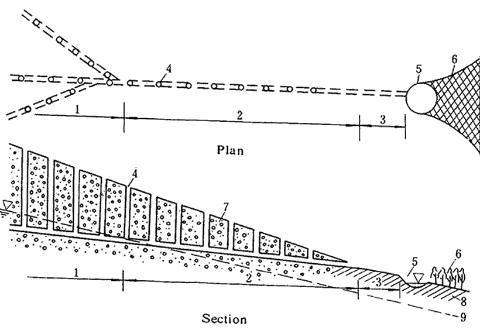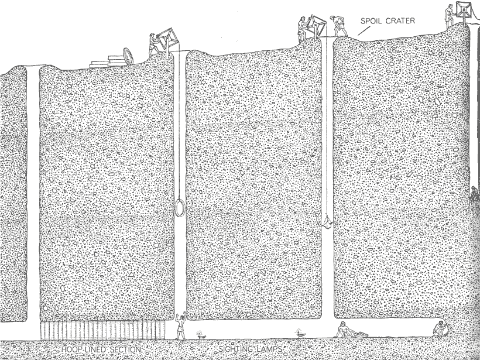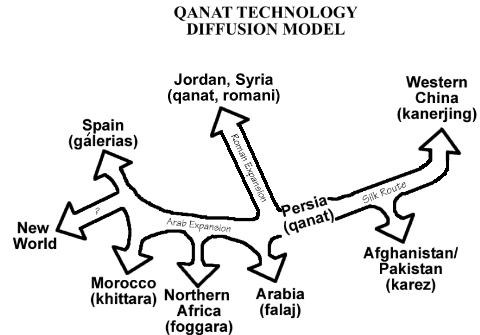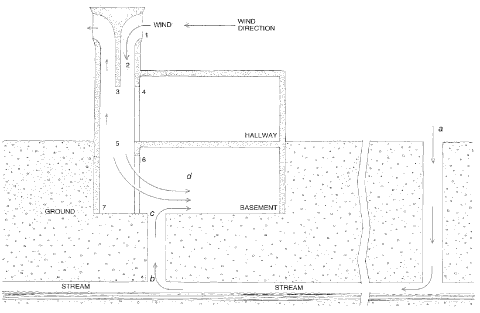Background
In the early part of the first millennium B.C., Persians started constructing elaborate tunnel systems called
qanats for extracting groundwater in the dry mountain basins of present-day Iran
(see figure 1). Qanat tunnels were hand-dug, just large enough to fit
the person doing the digging. Along the length of a qanat, which can be several kilometers, vertical
shafts were sunk at intervals of 20 to 30 meters to remove excavated material and to provide ventilation
and access for repairs. The main qanat tunnel sloped gently down from pre-mountainous alluvial fans to
an outlet at a village. From there, canals would distribute water to fields for irrigation. These
amazing structures allowed Persian farmers to succeed despite long dry periods when there was no
surface water to be had. Many qanats are still in use stretching from China on the east to
Morocco on the west, and even to the Americas.

Figure 1. General Schematic for a Qanat.
(1) Infiltration part of the tunnel
(2) Water conveyance part of the tunnel
(3) Open channel
(4) Vertical shafts
(5) Small storage pond
(6) Irrigation area
(7) Sand and gravel
(8) Layers of soil
(9) Groundwater surface
 | Click on the image for a larger version. |
There are significant advantages to a qanat water delivery system including: (1) putting the majority of the channel
underground reduces water loss from seepage and evaporation; (2) since the system is fed entirely by gravity,
the need for pumps is eliminated; and (3) it exploits groundwater as a renewable resource. The third benefit warrants
additional discussion.
The rate of flow of water in a qanat is controlled by the level of the underground water table. Thus a qanat
cannot cause significant drawdown in an aquifer because its flow varies directly with the subsurface water supply.
When properly maintained, a qanat is a sustainable system that provides water indefinitely. The self-limiting feature
of a qanat, however, is also its biggest drawback when compared to the range of technologies available today.
Water flows continuously in a qanat, and although some winter water is used for domestic
use, much larger amounts of irrigation water are needed during the daylight hours of the spring and summer growing
seasons. Although this continuous flow is frequently viewed as wasteful, it can,
in fact, be controlled. During periods of low water use in fall and winter, water-tight gates
can seal off the qanat opening damming up and conserving groundwater for periods of high demand.
In spring and summer, night flow may be stored in small reservoirs at the mouth of the qanat
and held there for daytime use.
Construction
Thanks to early writers, we have excellent descriptions of the techniques used by ancient qanat builders.
A recently discovered book by Mohammed Karaji,
a Persian scholar of the 10th Century AD, has a
chapter on qanat construction. The techniques he describes are basically the same as those practiced today,
eleven centuries later.
Qanats are constructed by specialists. A windlass is set up at the surface and the excavated soil is
hauled up in buckets (see photograph 1). The spoil is dumped around the
opening of the shaft to form a small mound; the latter feature keeps surface runoff from entering the shaft
bringing silt and other contamination with it. A vertical shaft 1 meter in diameter is thus dug out. A
gently sloping tunnel is then constructed which transports water from groundwater wells to the surface some
distance away. If the soil is firm, no lining is required for the tunnel. In loose soil, reinforcing rings
are installed at intervals in the tunnel to prevent cave-ins. These rings are usually made of burnt
clay (see figure 2). Mineral, salt, and other deposits which accumulate in the
channel bed necessitate periodic cleaning and maintenance work.

Figure 2. Constructing a qanat using reinforcing rings (from Scientific American).
 | Click on the image for a larger version. |
In countries like Syria, qanats are rapidly drying up. In a recent exercise, three sites
were chosen for renovation; each still had significant quantities of flowing water. The
selection of these sites was based on a national survey conducted in 2001. The renovation of
one the three (Drasiah qanat of Dmeir) was concluded in the spring of 2002.
Lessons learned from pilot projects like the one in Syria led to the development of
renovation criteria which included: (i) a stable groundwater level, (ii) a consistent underground
tunnel construction; (iii) social cohesion in the community using the qanat; (iv) existing system of
water rights and regulation; and (vi) willingness of the water users to contribute. Cleaning of an
ancient qanat is not an easy exercise. Not only is the work technically difficult, but also the social
organization associated with a qanat has major implications on its future viability (Wessels, 2000).
History
The precise dating of qanats is difficult, unless their construction was accompanied by
documentation or, occasionally, by inscriptions. Most of the evidence we have for the age of qanats
is circumstantial; a result of their association with the ceramics or ruins of ancient sites whose
chronologies have been established through archeological investigation, or the qanat technology being
introduced long ago by people whose temporal pattern of diffusion is known.
Written records leave little doubt that ancient Iran (Persia) was the birthplace of the qanat.
As early as the 7th century BC, the Assyrian king Sargon II reported that during a
campaign in Persia he had found an underground system for tapping water. His son, King Sennacherib, applied the
"secret" of using underground conduits in building an irrigation system around Nineveh.
During the period 550-331 BC, when Persian rule extended from the Indus to the Nile,
qanat technology spread throughout the empire. The Achaemenid rulers provided
a major incentive for qanat builders and their heirs by allowing them to
retain profits from newly-constructed qanats for five generations. As a result,
thousands of new settlements were established and others expanded. To the west, qanats
were constructed from Mesopotamia to the shores of the Mediterranean, as well as southward into parts
of Egypt. To the east of Persia, qanats were constructed in Afghanistan,
the Silk Route oases settlements of central Asia, and Chinese Turkistan (ie. Turpan).
During Roman-Byzantine era (64 BC to 660 AD), many qanats were constructed in Syria and Jordan.
From here, the technology appears have to diffused north and west into Europe. There is evidence of Roman
qanats as far away as the Luxembourg area.
The expansion of Islam initiated another major diffusion of qanat technology. The early Arab invasions
spread qanats westward across North Africa and into Cyprus, Sicily, Spain, and the Canary Islands. In Spain,
the Arabs constructed one system at Crevillente, most likely for agricultural use, and others at Madrid and
Cordoba for urban water supply. Evidence of New World qanats can be found in western Mexico, in the Atacama
regions of Peru, and Chile at Nazca and Pica. The qanat systems of Mexico came into use after the Spanish
conquest.
While the above diffusion model is nice and neat (see Figure 3), human activities are rarely so orderly.
Qanat technology may have been introduced into the central Sahara and later into western Sahara by Judaized
Berbers fleeing Cyrenaica during Trajan's persecution in 118 AD. Since the systems in South America may predate
the Spanish entry into the New World, their development may have occurred independently from any Persian influence.
The Chinese, while acknowledging a possible Persian connection, find an antecedent to the qanats of Turpan in the
Longshouqu Canal (constructed approximately 100 BC). The Romans used qanats
in conjunction with aqueducts to serve urban water supply systems (a qanat-aqueduct system was built in Roman Lyons).
A Roman qanat system was also constructed near
Murcia in southeastern Spain. The Catalan qanat systems (also in Spain)
do not seem to have been related to Islamic activity and are more likely later constructions, based on knowledge of
Roman systems in southern France.

Figure 3. One possibility for the diffusion of qanat technology.
 | Click on the image for a larger version. |
Qanats were an important factor in determining where people lived. The largest towns were still
located at low elevations on the floors of intermontane basins and in broad river valleys. Most of these
early settlements were defended by a fortress and watered by hand-dug wells sunk into a shallow water table.
Qanats enabled these settlements to grow by tapping water-rich
aquifers located deep beneath neighboring alluvial fans.
Even more dramatically, qanats made possible the establishment of permanent settlements
on the alluvial fans themselves. Earlier settlers had bypassed the areas because water tables there
were too deep for hand-dug wells, and the wadis on these slopes were too deeply incised in the fans for
simple diversion channels. In these locations, qanats tapped adjacent aquifers
with underground tunnels fed with water drawn from upslope alluvial deposits in mountain valleys. For
the first time, at these higher elevations, small qanat-watered hamlets appeared.
Present-Day Systems
An extensive system of qanats is still in use in Iran.
According to Wulff (1968): "The 22,000 qanats
in Iran, with their 170,000 miles of underground conduits all built by manual labor, deliver a total of 19,500
cubic feet of water per second - an amount equivalent to 75 percent of the discharge of the Euphrates River into
the Mesopotamian plain. This volume of water production would be sufficient to irrigate 3,000,000 acres of arid
land if it were used entirely for agriculture. It has made a garden of what would otherwise have been an
uninhabitable desert."
Qanats are still found throughout the regions that came under the cultural sphere of the
Persians, Romans, and Arabs. The qanat system in Turpan,
China, is still very much in use. In the Sahara region a number of oasis settlements are
irrigated by qanats, and some still call the underground conduits "Persian works."
The Palestinians and their neighbors had for some 2000 years irrigated terraces of olive groves,
vineyards, and orchards with water tapped from some 250 qanat-like tunnels beneath the hills on the eastern
shores of the Mediterranean. But today the terraces and tunnels are largely abandoned-unused since the day
in 1948 when Palestinians vacated following the creation of the state of Israel. The demise of these
irrigation systems is, according to Zvi Ron, an Israeli geographer from the University of Tel Aviv who has
mapped the tunnels, a human, ecological and cultural tragedy.
Qanats are to this day the major source of irrigation water for the fields and towering hillside
terraces that occupy parts of Oman and Yemen. They have for some 2000 years allowed
the villages of the desert fringes of the Arabian Peninsula to grow their own wheat as well as alfalfa
to feed their livestock. In these villages, there are complex ownerships of water rights and
distribution canals. In Oman, their importance was underlined in the 1980s with a government-funded
repair and upgrade program.
While an underground stream is called a qanat in Iran, it is called a karez in Afghanistan and
Pakistan, kanerjing in China, a falaj in the Arabian Peninsula, a qanat romani
in Jordan and Syria, a fogarra (fughara) in North Africa,
a khettara in Morocco, and a galeria in Spain (see figure 3).
Urban Layout
In some cities, water in qanats flows in tunnels beneath residential areas and
surfaces near the cultivated area. Staircases from the surface reach down
to these streams. The first access is usually at a public cistern where drinking water
is available to the entire community. Sometimes these cisterns are sizable vaults as much as 10 meters
across and 15 or more meters deep with spiral stairs leading down to small platforms at water level. In
cities like Herat in Afghanistan, these cisterns are ancient constructions encased in tile. Other more
modest urban access points are found along major streets, and even in some alleys, a
factor that probably played an important role in the social and physical layout of the town.
Where tunnels run beneath houses, private access points provide water
for various domestic uses. In wealthy homes, special rooms are constructed beside
the underground stream with tall shafts reaching upward to windtowers above roof level. Air caught by
the windtowers, which are oriented to prevailing summer winds, is forced down the shaft, circulates at
water level, and provides a cool refuge from the afternoon heat of summer.
Qanats as Phreatic Barometers
Dr. Dale Lightfoot at the Oklahoma State University has been using anecdotal information on qanats
to study the health of aquifers (Lightfoot, 2003). In southern Morocco, on the margins of the Sahara
Desert, lies the isolated oasis of Tafilaft. In the northern section of the oasis, water for irrigation
has, since the late-14th century, been provided by qanats (locally known as khettara). In all, 80 qanats
once provided water for 28 villages and irrigated about 3000 hectares. Beginning in the early 1970s, the
44 remaining active qanats began to experience reduced flow, and over the next two decades many more
qanats dried up and were abandoned.
Dr. Lightfoot has concluded that the diminishing and abandonment of qanats since the early
1970s is attributed to the Hassan Adahkil
Dam and Reservoir. The reservoir impounds surface water that used to flow unimpeded to the Tafilalt oasis.
Irrigation water is now carried to the oasis in concrete-lined canals, which do not allow for groundwater
recharge. Additionally, diesel-powered wells have become very popular. This combination of a lack of
recharge to the aquifer and the unregulated withdrawal of groundwater has resulted in a sharp drop in
the Tafilalt's water table since 1970 and the general abandonment of qanat irrigation.
Qanats are found over much of Syria, a "breadbasket" of the Roman, Byzantine, and the later Islamic
empires. After the world price for cotton increased in the 1950s, the Syrian government encouraged farmers
to produce more cotton to increase foreign exchange earnings. The widespread installation of groundwater
pumps has successfully antiquated the old qanat technology across most of the country. A map
showing the distribution of Syrian qanats, presents a picture of widespread abandonment, except in: (i) areas
where commercial irrigation with diesel pumps has only recently been introduced, or was soon abandoned because
of salinization problems or (ii) where rainfall is more plentiful and groundwater recharge is adequate. When
qanats go dry across a wide region, within a span of only a few decades, it indicates a regional problem with
groundwater stewardship.
Contemporary Experiences with Qanats
Dr. Jerry Buzzell described his experience visiting a qanat (falaj) in Mahdah, Oman. "This falaj begins
in the hills above town, with a very deep well to the aquifer. From there, tunnels have been dug channeling
the water to the town by gravity. In town, the falaj is a concrete trough, about a foot deep and two
feet wide, and the water flows swiftly."
"The falaj is communal, its water available to all, up to a (specific) point. Beyond this point, the
water is distributed into different channels, owned by different families, to irrigate date palms."
"Water flow into each channel is controlled by a metal plate across the falaj, which is lifted (to
allow water to flow into the channel) or lowered (to hold it back). The water is distributed to the
different channels for periods of time which depend upon factors such as the contribution of the
families to the construction and maintenance of the system, rents paid, etc."
"In the middle of the narrow space beside the falaj is a very basic sundial–a narrow rod stuck in the
ground, with the hours marked out with stones on either side of it–which is their method of timekeeping
and the basis of the distribution of the water (during daytime hours when the sun is shining)."
Dr. Buzzell was in Mahdah on a Friday and noted the falaj was being used for ritual cleaning in
preparation for prayers. "A lovely old man wearing a loincloth was sitting in the water, lathering
his body with soap, his white beard and the white fringe around his bald pate encircling twinkling
eyes and gap-toothed grin."
"When he was satisfied with his scrubbing, he lay down lengthwise in the falaj and allowed the water
to run over him, head to toe, washing the soap away with the dirt and leaving him clean enough to pray."
Qanats and Disease
Qanats were frequently used for domestic purposes, as well as irrigation. Because of this, they can
transport disease vectors (Afkhami, 1997). A chemical analysis of water, conducted in 1924, from 6 qanats as
they entered Tehran revealed water of potable quality in only 2 cases. In 3 other, water purity was
questionable and in 1 case the water was definitely unfit for drinking. These results were especially shocking
since the samples were taken from closed qanats before they were open to contamination. It has been hypothesized
that qanats were a major contributor to the cholera epidemics of the
19th century.
Throughout Iran, even if the qanat water was uninfected before entering the cities, it had ample opportunity
to become contaminated while traversing the urban areas in open ditches. With the lack of proper sewage and waste
disposal throughout Iranian municipalities, the cholera bacterium easily made its way into drinking water.
Passive Cooling Systems
Qanats can be used for cooling as well as water supply (Bahadori, p. 149). One technology operates
in conjunction with a wind tower. The arid regions of Iran have fairly fixed seasonal and daily wind
patterns. The wind tower harnesses the prevailing summer winds to cool and circulate it through a
building. A typical wind tower resembles a chimney, with one end in the basement of the building and
the other end rising from the roof. Wind tower technologies date back over 1000 years.
The passive cooling of a wind tower can be enhanced by connecting it to an underground stream or
qanat. In the system shown in figure 4, a shaft (b) connects
the qanat to the basement of the building
to be cooled. Hot dry air enters the qanat through one of its vertical shafts (a) and is cooled as it
flows along the water. Since the underground water is usually cold, the rate of cooling is quite high.
The wind tower is placed so that wind flowing through the basement door of the tower passes over the
top of the qanat tunnel. When the air flows from a large passage (the tunnel) through a
smaller one (the door), its pressure decreases. The pressure of the air from the tower is still
diminished when it passes over the top of the tunnel, so that cold moist air from the shaft is entrained
by the flow of cooled air from the tower (c). The mixture of air from the qanat and air from the tower
(d) circulates through the basement. A single qanat can serve several wind-tower systems.

Figure 4. The air flow in a combination wind tower/qanat cooling system (from Scientific American).
 | Click on the image for a larger version. |
Conclusion
A qanat system has a profound influence on the lives of the water users. It allows those living in a
desert environment adjacent to a mountain watershed to create a large oasis in an otherwise stark environment.
The United Nations and other organizations are encouraging the revitalization of traditional water harvesting
and supply technologies in arid areas because they feel it is important for sustainable water utilization.
References
Afkhami, A., 1997, "Disease and Water Supply: The Case of Cholera in 19th Century
Iran," Proceedings of Conference: Transformations of Middle Eastern Natural Environments: Legacies and Lessons,
Yale University, October.
Bahadori, M. N., 1978, "Passive Cooling Systems in Iranian Architecture," Scientific American, February, pp.144-154.
Beekman, C. S., P. S. Weigand, and J. J. Pint, 1999, "Old World Irrigation Technology in a New World
Context: Qanats in Spanish Colonial Western Mexico," Antiquity 73(279): 440-446.
English, P., 1997, "Qanats and Lifeworlds in Iranian Plateau Villages," Proceedings
of the Conference: Transformation of Middle Eastern Natural Environment: Legacies and Lessons, Yale University, October.
Lightfoot, D., 2003, "Traditional Wells as Phreatic Barometers: A View from Qanats and Tube Wells in
Developing Arid Lands," Proceedings of the UCOWR Conference: Water Security in the
21st Century, Washington, DC, July.
Pazwash, N. 1983. "Iran's Mode of Modernization: Greening the Desert, Deserting the Greenery," Civil Engineering,
March. pp. 48-51.
United Nationals Environmental Programme, 1983. Rain and Water Harvesting in Rural Area.
Tycooly International Publishing Limited, Dublin, pp 84-88.
Wessels, K (2000), Renovating Qanats in a changing world, a case study in Syria, paper
presented to the International Syposuim on Qanats, May 2000, Yazd, Iran.
Wulff, H.E., 1968, "The Qanats of Iran," Scientific American, April, p. 94-105.
(http://users.bart.nl/~leenders/txt/qanats.html)